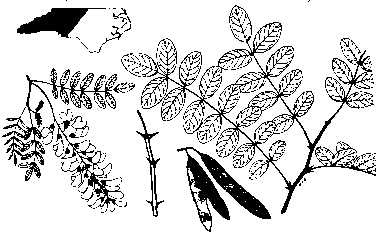|
Black
Locust
(Robinia
pseudoacacia L)
|
|
| |
 |
|
| |
Black
locust, often called yellow locust, is native only to the mountains.
However it has been widely planted across the state and is now
naturalized on all soils and moisture conditions, except saturated
soils. It is found as a forest tree only in the mountains. In
other sections of the state, it usually grows in thickets on clay
banks or waste places, or singularly along fence rows.
Black locust leaves are pinnately compound and 8 to 14 inches
long. Each leaf is made up of seven to 19 oval alternate leaflets
on the long, slender rachis or central stem. Margins of leaflets
are smooth. The whitish flowers are very fragrant and hang in
clusters on long stems.
Black locust fruit is in the form of brown flat pods, each bearing
four to eight kidney-shaped, dark orange-brown seeds. Most pods
persist on the tree through the winter.
The tree grows on a variety of soils and is the most successful
species for use in reclaiming spoil banks from mining operations.
It may reach heights of 70 to 80 feet and diameters of 3 to 4
feet, but more frequently is 30 to 70 feet tall and 1 to 2 feet
in diameter.
Twigs bear paired spines, 1/2 to 1 inch long, that arise adjacent
to each leaf scar. The thick bark is deeply furrowed, dark brown
and scaly. Sprouts and seedlings are important food for cottontail
rabbits and other browsing animals in winter, especially when
snow accumulates. Many birds also eat black locust seeds.
The locust borer attacks many locust trees when they are only
a few years old, resulting in deformed and weakened trunks. The
wood is yellow, coarse-grained, very heavy, very hard, strong
and very resistant to decay. It is used extensively for fence
posts, poles, split rails, insulator pins, decking and in other
places where hard, strong, decay-resistant wood is needed. |
|
|

